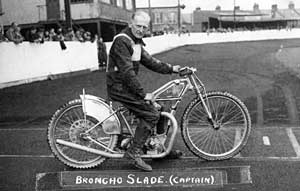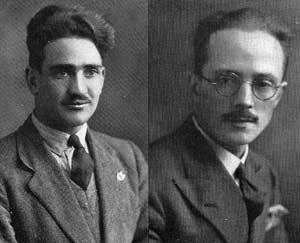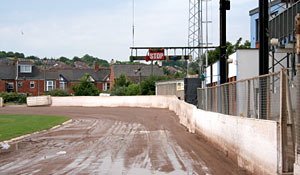
- Home
- Memories
- Scrapbook ▽
- Topics ▽
- People ▽
- Events
- Photos
- Site Map
- Timeline
Page updated 24 October 2008
Back to sports centres
Also see: Falcons riders 1947 - 2005
And 6000 Morrison shelters and the Falcons
The noisy, cinder strewn sport of motorcycle speedway has been as much a part of Exeter's 20th-Century sporting life, as the Exeter City football club for some.
We have to travel to Australia for the birth of the sport. In 1923, Johnnie S Hoskins, a New Zealander, found himself in Maitland, New South Wales as secretary to the local Agricultural Society. The Society was heavily in debt so Hoskins started the Electric Light Carnival to raise funds. One of the attractions was motorbike racing on a dirt track. Locals would arrive on their bikes, strip them of the mudguards and race around a dirt track - it was an immediate success and soon the Society was able to pay off its debts. Thus the sport of speedway was born. In 1925 the first purpose built stadium opened in Newcastle, New South Wales.
An Englishman, Stanley Glanfield saw the sport when he visited Brisbane in 1927, while becoming the first man to ride a motorcycle around the world. He decided to introduce the sport in Britain and with a small team of Australian riders, he staged the first race in Epping Forest in February 1928. By the summer, over sixty tracks had opened.
Glanfield's brother Leonard had been born in Exeter. With Stanley's support he decided to stage speedway at the County Ground, a former cricket ground and enlisted Mr F Cottey who became Mayor in 1951, and a Mr Henley to form a company. A five year lease at £300 per year was agreed and Southern Speedways Ltd was in business. Surrounding the pitch was an asphalt cycle track, and in late January 1929, it was ripped up, the corners widened to 40 ft and the whole laid with ground cinders. The total racing length was 413 yards. A safety barrier, forty floodlights and a public address system installed, making the course ready for the first race.
On the 2 March 1929, a preview was staged after a Devon v Gloucester rugby match when, Exonian, Freddie Hore and 16 year old Aussie, 'Bert Cyclone' Spencer lapped the new track to give the attendant spectators a taste of what was to come.
On the 9 March 1929 the first spectators for the Exeter Speedway started passing through the turnstiles. They were charged 2 shillings and 3 shillings for the grandstand and 1 shilling and 1 and 6 for the ground. At 8 pm, the Mayor cut a white ribbon in front of a crowd of 11,000 to declare the new track open. This was followed by a parade of riders from Australia, South Africa and elsewhere in England, as well as some locals. That first night there were heats in the two main competitions, the Exeter Handicap and Golden Helmet. There were several attempts to break the lap record and the inevitable crashes. The Exeter crowd had never seen anything like and were enthusiastic enough to ensure that the rest of the meetings in the first year regularly had 10,000 plus spectators.
An early, Exeter born rider was Frank 'Buster' Buckland. Frank's parents were the caretakers at Rougemont Castle. He played rugby for Exeter and was by trade an electrician. Frank helped to erect the floodlights for the speedway and having watched the riders practice asked if he could have a go. Within weeks he became a star rider and later rode for Crystal Palace in London. After WWII he became the Falcons' promoter before emigrating to Australia.
The initial enthusiasm was short lived and in October 1929 Leonard Glanfield and Southern Speedways pulled out, to be replaced by the Crystal Palace promoters Red Mockford and Cecil Smith. During 1930, crowds started to expand and women's races are held for the first time. An England team rode against an Australian team in an unofficial test match resulting in a 24-28 defeat for England. A few weeks later, a repeat meeting gives England a 30-24 win.
By 1931, attendances were low despite the change of race nights to Wednesday, and there was no noticeable increase in crowd size. On 22 July the last meeting under County Speedways took place. Two weeks later it was announced that Exeter Speedway had closed and the promoters had gone into liquidation. Nothing could be done to save Exeter and Messrs Mockford and Smith went back to London where they continued to promote speedway at Crystal Palace.
In April 1934 racing recommenced to encouraging crowds, but by June, numbers had dropped to 800, forcing yet another closure.
It was in 1945 that speedway was next resurrected in Exeter, becoming a regular attraction for thousands of locals away from the football field. A popular rider at the time was Broncho Slade who captained the Falcons in 1947 and later became team manager. For many years he owned a little garage in Church Road next door to the stadium until his death in 1981.
On 10 October 2005, the speedway team, the Exeter Falcons stopped racing at the County Ground in preparation for its demolition and the building of housing.
In October 2008, Allen Trump received permission from Devon County Council to build a new track at Haldon for the Falcons. Trump will fund half the projected cost of £500,000, while half will come from the estate of Colin Hill, a former promoter.
It is planned that the track will be set three to four feet into a bowl, giving the spectators an unique view from above. A grandstand will be built to make the track the best in the country. Others who have helped to keep the spirit of the Falcons alive in the interim include Tony Lethbridge, David Short, Brian James, Sandra Bishop and Mike Spearpoint.
Sources - The Story of Exeter Speedway by Tony Lethbridge the Express and Echo and Tony Lethbridge.
 The 1929 start photo from the County Ground.
The 1929 start photo from the County Ground.
 Broncho Slade who captained the Falcons in 1947.
Broncho Slade who captained the Falcons in 1947.
 Frank
'Buster' Buckland an early rider left, and Leonard Glanfield, one
of the original founders. All historic photos
courtesy of Tony Lethbridge.
Frank
'Buster' Buckland an early rider left, and Leonard Glanfield, one
of the original founders. All historic photos
courtesy of Tony Lethbridge.
 The
County Ground before it closed, where the Falcons rode.
The
County Ground before it closed, where the Falcons rode.
│ Top of Page │